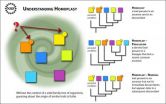(Press-News.org) With the genetics of so many organisms that have different traits yet to study, and with the techniques for gathering full sets of genetic information from organisms rapidly evolving, the "forest" of evolution can be easily lost to the "trees" of each individual case and detail.
A review paper published this week in Science by David Wake, Marvalee Wake and Chelsea Specht, all currently National Science Foundation grantees, suggests that studying examples of homoplasy can help scientists analyze the overwhelming deluge of genetic data and information that is currently being generated.
For example, studying situations where a derived trait surfaces in two lineages that lack a recent common ancestor, or situations where an ancestral trait was lost but then reappeared many generations later, may help scientists identify the processes and mechanisms of evolution.
The authors provide many fascinating examples of homoplasy, including different species of salamanders that independently, through evolution, increased their body-length by increasing the lengths of individual vertebrae. By contrast, most species grow longer by adding vertebrae through evolution.
The authors also explain how petals in flowers have evolved on six separate occasions in different plants. A particularly striking example of homoplasy cited by the authors is the evolution of eyes, which evolved many times in different groups of organisms--from invertebrates to mammals--all of which share an identical genetic code for their eyes.
These kinds of examples of genetic and developmental biology help scientists elucidate relationships between organisms, as well as develop a fuller picture of their evolutionary history.
INFORMATION:
Homoplasy: A good thread to pull to understand the evolutionary ball of yarn
Studying the many potential reasons why the same trait has independently evolved in different species (homoplasy) can improve our understanding of the genetic, developmental and evolutionary relationships among species
2011-02-28
ELSE PRESS RELEASES FROM THIS DATE:
A North American first at the Montreal Heart Institute could help treat thousands of Canadians
2011-02-28
Montreal, February 24, 2011 – The interventional cardiology team at the Montreal Heart Institute (MHI) recently began patient enrolment for a new device, the Neovasc ReducerTM, designed to treat patients suffering from refractory angina. The treatment method is a first in North America and is being conducted as part of an international study, the COSIRA trial. This innovative treatment is promising for thousands of Canadians disabled by refractory angina and who lack alternatives for relieving their symptoms and improving their quality of life.
Developed in Canada by ...
Strong link found between victimization, substance abuse
2011-02-28
A strong link between victimization experiences and substance abuse has been discovered by researchers at the University of Illinois at Chicago.
The correlation is especially prevalent among gays, lesbians and bisexuals -- more so than in heterosexuals, says Tonda Hughes, professor and interim head of health systems science in the UIC College of Nursing. Hughes is lead author of the study, published in the journal Addiction.
Researchers compared victimization experiences of unwanted sexual activity, neglect, physical violence, and assault with a weapon, across four ...
ONR's TechSolutions creating green ideas that light up ships and submarines
2011-02-28
ARLINGTON, Va. - One Sailor's request to replace humming fluorescent bulbs with a quiet alternative inspired the Office of Naval Research (ONR) to create the Solid State Lighting (SSL) project, currently being evaluated aboard several ships and submarines across the U.S. Navy.
A product of ONR's TechSolutions program, SSL is one of several rapid-response technologies created using recommendations and suggestions from Navy and Marine Corps personnel. (Watch TechSolutions products in action via YouTube.)
The SSL project introduced the energy-saving, nonhazardous LED ...
Making the 'irrelevant' relevant to understand memory and aging
2011-02-28
Age alters memory. But in what ways, and why? These questions comprise a vast puzzle for neurologists and psychologists. A new study looked at one puzzle piece: how older and younger adults encode and recall distracting, or irrelevant, information. The results, published in Psychological Science, a journal of the Association of Psychological Science, can help scientists better understand memory and aging.
"Our world contains so much information; we don't always know which is relevant and which is irrelevant," said Nigel Gopie, who cowrote the study with Fergus I.M. Craik ...
Missing sugar molecule raises diabetes risk in humans
2011-02-28
Researchers at the University of California, San Diego School of Medicine and Rady Children’s Hospital-San Diego say an evolutionary gene mutation that occurred in humans millions of years ago and our subsequent inability to produce a specific kind of sialic acid molecule appears to make people more vulnerable to developing type 2 diabetes, especially if they’re overweight.
The findings are published in the Feb. 24 online edition of The FASEB Journal, a publication of the Federation of American Societies of Experimental Biology.
Corresponding study author, Jane ...
Examining climate change effects on wheat
2011-02-28
Wheat growers in the Southwest have a better idea about how to adjust to climate change in the decades ahead, thanks to U.S. Department of Agriculture (USDA) scientists in Arizona.
Researchers with the USDA's Agricultural Research Service (ARS) installed infrared heaters in experimental wheat fields at the agency's Arid-Land Agricultural Research Center in Maricopa, Ariz., to simulate growing conditions expected by 2050. ARS is USDA's principal intramural scientific research agency, and this research supports the USDA priority of responding to climate change.
Wheat ...
Rituximab and fludarabine produce long-term remissions in CLL
2011-02-28
COLUMBUS, Ohio – New research shows that a less-toxic combination of a targeted immune-based drug and a chemotherapy drug can produce long-term remissions in some chronic lymphocytic leukemia patients. And it does so without increasing the risk of later therapy-related myelodysplastic syndrome and acute myeloid leukemia, which can often occur with a three-drug combination used to treat these patients.
The multi-institutional study, led by researchers at the Ohio State University Comprehensive Cancer Center – Arthur G. James Cancer Hospital and Richard J. Solove Research ...
Genetically modified fungi kill malaria-causing parasites in mosquitoes
2011-02-28
Spraying malaria-transmitting mosquitoes with a genetically modified fungus can kill the malaria parasite without harming the mosquito, potentially reducing malaria transmission to humans, according to a new study published in the journal Science. Funded by the National Institute of Allergy and Infectious Diseases (NIAID), part of the National Institutes of Health, the study was led by Raymond J. St. Leger, Ph.D., of the University of Maryland, College Park.
An estimated 225 million malaria cases occur worldwide annually, resulting in about 781,000 deaths each year, ...
Drier conditions projected to accelerate dust storms in the southwest
2011-02-28
MOAB, Utah — Drier conditions projected to result from climate change in the Southwest will likely reduce perennial vegetation cover and result in increased dust storm activity in the future, according to a new study by scientists with the U.S. Geological Survey and the University of California, Los Angeles.
The research team examined climate, vegetation and soil measurements collected over a 20-year period in Arches and Canyonlands National Parks in southeastern Utah. Long-term data indicated that perennial vegetation in grasslands and some shrublands declined with temperature ...
GSA Bulletin highlights: New research posted Feb. 4-11, 2011
2011-02-28
Boulder, CO, USA - GSA BULLETIN is now posting pre-issue publication content -- finalized papers that are ready to go to press and not under embargo. GSA invites you to sign up for e-alerts and be the first to have access to new journal content as it becomes available. Sign in at http://www.gsapubs.org/cgi/alerts with your e-mail address to manage subscriptions for pre-issue postings, full tables of contents alerts, and more.
Keywords: Silicic calderas, Quaternary, Iberian Peninsula, Tsuboi's technique, Colorado River, Gran Desierto dune field, ASTER. Eel River, LiDAR, ...
LAST 30 PRESS RELEASES:
Study links genetic variants to risk of blinding eye disease in premature infants
Non-opioid ‘pain sponge’ therapy halts cartilage degeneration and relieves chronic pain
AI can pick up cultural values by mimicking how kids learn
China’s ecological redlines offer fast track to 30 x 30 global conservation goal
Invisible indoor threats: emerging household contaminants and their growing risks to human health
Adding antibody treatment to chemo boosts outcomes for children with rare cancer
Germline pathogenic variants among women without a history of breast cancer
Tanning beds triple melanoma risk, potentially causing broad DNA damage
Unique bond identified as key to viral infection speed
Indoor tanning makes youthful skin much older on a genetic level
Mouse model sheds new light on the causes and potential solutions to human GI problems linked to muscular dystrophy
The Journal of Nuclear Medicine ahead-of-print tip sheet: December 12, 2025
Smarter tools for peering into the microscopic world
Applications open for funding to conduct research in the Kinsey Institute archives
Global measure underestimates the severity of food insecurity
Child survivors of critical illness are missing out on timely follow up care
Risk-based vs annual breast cancer screening / the WISDOM randomized clinical trial
University of Toronto launches Electric Vehicle Innovation Ontario to accelerate advanced EV technologies and build Canada’s innovation advantage
Early relapse predicts poor outcomes in aggressive blood cancer
American College of Lifestyle Medicine applauds two CMS models aligned with lifestyle medicine practice and reimbursement
Clinical trial finds cannabis use not a barrier to quitting nicotine vaping
Supplemental nutrition assistance program policies and food insecurity
Switching immune cells to “night mode” could limit damage after a heart attack, study suggests
URI-based Global RIghts Project report spotlights continued troubling trends in worldwide inhumane treatment
Neutrophils are less aggressive at night, explaining why nighttime heart attacks cause less damage than daytime events
Menopausal hormone therapy may not pose breast cancer risk for women with BRCA mutations
Mobile health tool may improve quality of life for adolescent and young adult breast cancer survivors
Acupuncture may help improve perceived breast cancer-related cognitive difficulties over usual care
Nerve block may reduce opioid use in infants undergoing cleft palate surgery
CRISPR primes goldenberry for fruit bowl fame
[Press-News.org] Homoplasy: A good thread to pull to understand the evolutionary ball of yarnStudying the many potential reasons why the same trait has independently evolved in different species (homoplasy) can improve our understanding of the genetic, developmental and evolutionary relationships among species

